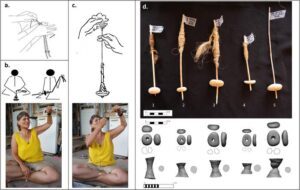
PLOS—A collection of perforated pebbles from an archaeological site in Israel may be spindle whorls, representing a key milestone in the development of rotational tools including wheels, according to a study published November 13, 2024 in the open-access journal PLOS ONE by Talia Yashuv and Leore Grosman from the Hebrew University of Jerusalem, Israel.
Donut-shaped objects connected to a bar, forming a wheel and axle, are a key invention springboarding technological development and are commonly associated with Bronze Age carts. Spindle whorls, round, weighted objects that are attached to a spindle stick, form a similar wheel-and-axle-like device to help the spindle rotate faster and longer, enabling it to efficiently gather up fibers such as wool or flax and spin them into yarn.
The stones studied in the new paper, recovered from the Nahal-Ein Gev II dig site in northern Israel, date back approximately 12,000 years, during the important transition to an agricultural lifestyle and the Neolithic period, long before the cart wheels of the Bronze Age. Introducing an innovative method for studying perforated objects, based on digital 3-D models of the stones and their negative holes, the authors describe more than a hundred of the mostly-limestone pebbles, which feature a circular shape perforated by a central hole. Due to this structure and composition, the authors of the new paper deduce that the stones were likely used as spindle whorls — a hypothesis also supported by successfully spinning flax using replicas of the stones.
This collection of spindle whorls would represent a very early example of humans using rotation with a wheel-shaped tool. They might have paved the way for later rotational technologies, such as the potter’s wheel and the cart wheel, which were vital to the development of early human civilizations.
The authors add: “The most important aspect of the study is how modern technology allows us to delve deep into touching the fingerprints of the prehistoric craftsman, then learn something new about them and their innovativeness, and at the same time, about our modern technology and how we’re linked.”
_____________________________

Spinning methods. (a) Manual thigh-spinning [64]; (b) Spindle-and-whorl “supported spinning” [68]; (c) “drop spinning” [66]; (d) the experimental spindles and whorls, the 3D scans of the pebbles and their negative perforations. The bottom pictures show Yonit Kristal experimenting spinning fibres with replicas of the perforated pebbles, using supported spinning and drop spinning techniques (photographed by Talia Yashuv). Yashuv, Grosman, 2024, PLOS ONE, CC-BY 4.0 (https://creativecommons.org/licenses/by/4.0/)
Article Source: PLoS ONE news release.
*Yashuv T, Grosman L (2024) 12,000-year-old spindle whorls and the innovation of wheeled rotational technologies. PLoS ONE 19(11): e0312007. https://doi.org/10.1371/journal.pone.0312007
_____________________________
Advertisement

EXPLORE THE ANCIENT ETRUSCANS IN PERSON!
Experience a unique, up-close-and-personal hike among ancient hilltop towns in central Italy. You will walk the sensational countryside of the regions of Umbria and Tuscany, soaking in important sites attesting to the advanced Etruscan civilization, forerunners of the ancient Romans; imposing architectural and cultural remains of Medieval Italy; local food and drink; and perhaps best of all — spectacular scenic views! Join us in this collaborative event for the trip of a lifetime!


